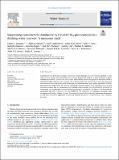Files in this item
Suppressing cyanobacterial dominance by UV-LED TiO2-photocatalysis in a drinking water reservoir : a mesocosm study
Item metadata
| dc.contributor.author | Pestana, Carlos J. | |
| dc.contributor.author | Santos, Allan A. | |
| dc.contributor.author | Capelo-Neto, José | |
| dc.contributor.author | Melo, Vânia M.M. | |
| dc.contributor.author | Reis, Kelly C. | |
| dc.contributor.author | Oliveira, Samylla | |
| dc.contributor.author | Rogers, Ricardo | |
| dc.contributor.author | Pacheco, Ana B.F. | |
| dc.contributor.author | Hui, Jianing | |
| dc.contributor.author | Skillen, Nathan C. | |
| dc.contributor.author | Barros, Mário U.G. | |
| dc.contributor.author | Edwards, Christine | |
| dc.contributor.author | Azevedo, Sandra M.F.O. | |
| dc.contributor.author | Robertson, Peter K.J. | |
| dc.contributor.author | Irvine, John T.S. | |
| dc.contributor.author | Lawton, Linda A. | |
| dc.date.accessioned | 2022-11-08T10:30:20Z | |
| dc.date.available | 2022-11-08T10:30:20Z | |
| dc.date.issued | 2022-11-01 | |
| dc.identifier | 282056639 | |
| dc.identifier | e6bb1aa1-12c1-4f79-9718-14704dd841fe | |
| dc.identifier | 85140882794 | |
| dc.identifier | 000879870000002 | |
| dc.identifier.citation | Pestana , C J , Santos , A A , Capelo-Neto , J , Melo , V M M , Reis , K C , Oliveira , S , Rogers , R , Pacheco , A B F , Hui , J , Skillen , N C , Barros , M U G , Edwards , C , Azevedo , S M F O , Robertson , P K J , Irvine , J T S & Lawton , L A 2022 , ' Suppressing cyanobacterial dominance by UV-LED TiO 2 -photocatalysis in a drinking water reservoir : a mesocosm study ' , Water Research , vol. 226 , 119299 . https://doi.org/10.1016/j.watres.2022.119299 | en |
| dc.identifier.issn | 0043-1354 | |
| dc.identifier.other | RIS: urn:92DFD56A9C431E27E0440149EA98FD42 | |
| dc.identifier.other | ORCID: /0000-0002-8394-3359/work/122719754 | |
| dc.identifier.uri | https://hdl.handle.net/10023/26323 | |
| dc.description | Funding: The authors would like to acknowledge the Engineering and Physical Sciences Research Council (EPSRC) [EP/P029280/1], the Coordination for the Improvement of Higher Education Personnel - CAPES [PROEX 20/2016 and Print 88887.311806/2018-00], the Brazilian National Research Council – CNPq [403116/2016-3 and 304164/2017-8] and the Ceará Research Support Foundation - FUNCAP [PNE-0112-00042.01.00/16] for funding this research. | en |
| dc.description.abstract | Cyanobacteria and their toxic secondary metabolites present challenges for water treatment globally. In this study we have assessed TiO2 immobilized onto recycled foamed glass beads by a facile calcination method, combined in treatment units with 365 nm UV-LEDs. The treatment system was deployed in mesocosms within a eutrophic Brazilian drinking water reservoir. The treatment units were deployed for 7 days and suppressed cyanobacterial abundance by 85% while at the same time enhancing other water quality parameters; turbidity and transparency improved by 40 and 81% respectively. Genomic analysis of the microbiota in the treated mesocosms revealed that the composition of the cyanobacterial community was affected and the abundance of Bacteroidetes and Proteobacteria increased during cyanobacterial suppression. The effect of the treatment on zooplankton and other eukaryotes was also monitored. The abundance of zooplankton decreased while Chrysophyte and Alveolata loadings increased. The results of this proof-of-concept study demonstrate the potential for full-scale, in-reservoir application of advanced oxidation processes as complementary water treatment processes. | |
| dc.format.extent | 13 | |
| dc.format.extent | 11600206 | |
| dc.language.iso | eng | |
| dc.relation.ispartof | Water Research | en |
| dc.subject | Phytoplankton | en |
| dc.subject | Advanced oxidation processes | en |
| dc.subject | Water quality | en |
| dc.subject | Microbial community | en |
| dc.subject | 16S/18S rRNA sequencing | en |
| dc.subject | Mesocosm | en |
| dc.subject | QR Microbiology | en |
| dc.subject | NDAS | en |
| dc.subject | MCC | en |
| dc.subject.lcc | QR | en |
| dc.title | Suppressing cyanobacterial dominance by UV-LED TiO2-photocatalysis in a drinking water reservoir : a mesocosm study | en |
| dc.type | Journal article | en |
| dc.contributor.sponsor | EPSRC | en |
| dc.contributor.institution | University of St Andrews. School of Chemistry | en |
| dc.contributor.institution | University of St Andrews. Centre for Energy Ethics | en |
| dc.contributor.institution | University of St Andrews. Centre for Designer Quantum Materials | en |
| dc.contributor.institution | University of St Andrews. EaSTCHEM | en |
| dc.identifier.doi | 10.1016/j.watres.2022.119299 | |
| dc.description.status | Peer reviewed | en |
| dc.identifier.grantnumber | EP/P029280/1 | en |
This item appears in the following Collection(s)
Items in the St Andrews Research Repository are protected by copyright, with all rights reserved, unless otherwise indicated.

